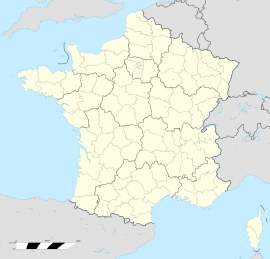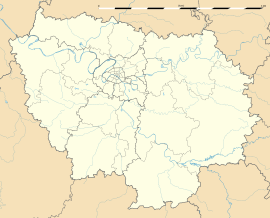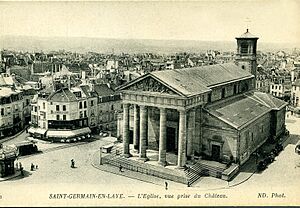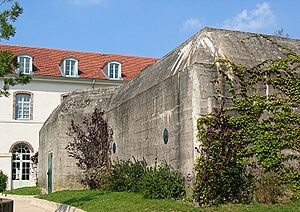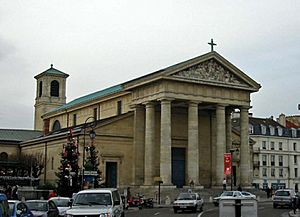Saint-Germain-en-Laye facts for kids
Quick facts for kids
Saint-Germain-en-Laye
|
||
|---|---|---|
|
Subprefecture and commune
|
||
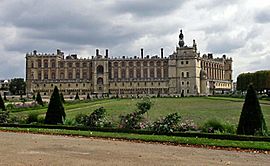
|
||
|
||
| Country | France | |
| Region | Île-de-France | |
| Department | Yvelines | |
| Arrondissement | Saint-Germain-en-Laye | |
| Canton | Saint-Germain-en-Laye | |
| Intercommunality | CA Saint Germain Boucles Seine | |
| Area
1
|
51.94 km2 (20.05 sq mi) | |
| Population
(2021)
|
44,380 | |
| • Density | 854.45/km2 (2,213.0/sq mi) | |
| Demonym(s) | Saint-Germanois Saint-Germinois |
|
| Time zone | UTC+01:00 (CET) | |
| • Summer (DST) | UTC+02:00 (CEST) | |
| INSEE/Postal code |
78551 /78100 & 78112
|
|
| Elevation | 22–107 m (72–351 ft) (avg. 78 m or 256 ft) |
|
| 1 French Land Register data, which excludes lakes, ponds, glaciers > 1 km2 (0.386 sq mi or 247 acres) and river estuaries. | ||
Saint-Germain-en-Laye is a town in the Yvelines area of north-central France. It's located in the western suburbs of Paris, about 19 kilometers (12 miles) from the center of the city.
People who live here are called Saint-Germanois or Saint-Germinois. It's known as one of the fancier suburbs of Paris, with nice streets and high-end places to visit.
Saint-Germain-en-Laye is a sub-prefecture, which means it's an important administrative center for the department. It includes a large part of the National Forest of Saint-Germain-en-Laye. This makes it the biggest town in the Yvelines area, covering about 48 square kilometers (18.5 square miles). The town is also located in a big curve of the Seine River. You can easily get there by train, as it's one of the last stops on RER Line A.
Contents
History of Saint-Germain-en-Laye
Saint-Germain-en-Laye was started in 1020. This was when King Robert the Pious (who ruled from 996 to 1031) built a convent where the Church of Saint-Germain stands today.
Royal Connections and the Château
Before the French Revolution in 1789, Saint-Germain-en-Laye was a royal town. The Château de Saint-Germain (a large castle) was home to many French kings and queens. The old castle was first built in 1348 by King Charles V. It was built on the remains of an even older castle from 1238, from the time of Saint Louis.
Later, Francis I helped restore the castle. In 1862, Napoleon III turned the old royal castle into the Musée des Antiquités Nationales. This museum shows items from ancient times, from the Stone Age to the Celtic period. One of its most famous items is the "Dame de Brassempouy". This is a small sculpture made from a mammoth's ivory tusk about 23,000 years ago.
Kings Henry IV and Louis XIII also spent time in the town. Louis XIV was born in the château. Because of this, the town's coat of arms shows a baby's cradle and his birth date. Louis XIV made Saint-Germain-en-Laye his main home from 1661 to 1681.
Exiled King and the Grand Terrace
In 1688, James II of England (who was also James VII of Scotland) was removed from his throne in what's known as the Glorious Revolution. He came to Saint-Germain-en-Laye to live in exile. Louis XIV let him live in the Château. James lived there for 13 years and died on September 16, 1701. His daughter, Louisa Maria Stuart, was also born there in 1692. James II is buried in the town's church.
Saint-Germain-en-Laye is also famous for its 2.4-kilometer (1.5-mile) long stone terrace. This terrace was built by André Le Nôtre between 1669 and 1673. From the terrace, you can see a beautiful view of the Seine River valley and even Paris in the distance.
During the French Revolution, many places changed their names if they sounded too royal or religious. Saint-Germain-en-Laye was temporarily called Montagne-du-Bon-Air (Mountain of Good Air). Later, during his rule, Napoleon I set up a training school for his cavalry officers in the old Château.
Modern History and Mergers
The Treaty of Saint-Germain was signed here in 1919. This treaty officially recognized the breakup of the old Habsburg empire. It led to new independent countries like Czechoslovakia, Poland, Hungary, and Yugoslavia.
During World War II, from 1940 to 1944, the town was the main headquarters for the German armed forces on the Western Front.
On January 1, 2019, the nearby town of Fourqueux joined with Saint-Germain-en-Laye.
Saint-Germain Parish Church
The main church in town is dedicated to Germain of Paris. The first church on this spot was built in the 11th century. The current building, which is the fourth one, was built in the 1820s. It has a Neoclassical style with six large columns at the front.
Inside the church, you can find the tomb of James II of England. Even Queen Victoria visited this church in 1855. The church's organ, first put in place in 1698, was rebuilt in the 19th century. Famous organists like Marie-Claire Alain have played here.
Population
The numbers below show how many people have lived in Saint-Germain-en-Laye over the years. These figures are for the town itself and do not include the population of Fourqueux, which joined in 2019.
| Historical population | |||||||||||||||||||||||||||||||||||||||||||||||||||||||||||||||||||||||||||||||||||||||||||||||||||||||||||||||||||
|---|---|---|---|---|---|---|---|---|---|---|---|---|---|---|---|---|---|---|---|---|---|---|---|---|---|---|---|---|---|---|---|---|---|---|---|---|---|---|---|---|---|---|---|---|---|---|---|---|---|---|---|---|---|---|---|---|---|---|---|---|---|---|---|---|---|---|---|---|---|---|---|---|---|---|---|---|---|---|---|---|---|---|---|---|---|---|---|---|---|---|---|---|---|---|---|---|---|---|---|---|---|---|---|---|---|---|---|---|---|---|---|---|---|---|---|
|
|
||||||||||||||||||||||||||||||||||||||||||||||||||||||||||||||||||||||||||||||||||||||||||||||||||||||||||||||||||
| Source: EHESS and INSEE (2007-2017) | |||||||||||||||||||||||||||||||||||||||||||||||||||||||||||||||||||||||||||||||||||||||||||||||||||||||||||||||||||
Transportation in Saint-Germain-en-Laye
Saint-Germain-en-Laye has good transport links. The Résalys bus network helps people travel around the area.
Train and Tram Services
The town is served by the Saint-Germain-en-Laye station on Paris RER line A. The RER is a fast train system that connects Paris with its suburbs.
There were also two stations on the Grande Ceinture Ouest suburban rail line. These were Saint-Germain-Bel-Air–Fourqueux and Saint-Germain–Grande Ceinture. This line operated from 2004 to 2019.
On July 6, 2022, the Île-de-France tramway Line 13 Express opened. This new tram line now serves the two former Grande Ceinture Ouest stations. It also has two more stations within Saint-Germain-en-Laye.
The Achères–Grand-Cormier station is also in the Saint-Germain-en-Laye area. It's served by the Paris RER line A and another suburban rail line called Transilien Paris – Saint-Lazare. This station is in the middle of the Forest of Saint-Germain-en-Laye, away from the main town.
Sports in Saint-Germain-en-Laye
Saint-Germain-en-Laye has a strong history in football.
Football History
From 1904 to 1970, the town had a football team called Stade Saint-Germain. In 1970, this team merged with Paris FC to become Paris Saint-Germain (PSG). PSG is now one of the top football teams in France and has won many trophies.
Sporting Facilities
The main sports area in Saint-Germain-en-Laye is the Stade Municipal Georges Lefèvre. It's a huge area, covering over 12 hectares (about 30 acres). It includes:
- 5 football fields
- 3 spectator stands
- 1 athletic track for running
- 22 tennis courts
- 1 clubhouse
- 1 multi-sport beach area
Economy
Capcom Entertainment France, which is part of the video game company Capcom, has its main office in Saint-Germain-en-Laye.
Education
As of 2016, there were 20,581 students in schools in this town. About 7,300 of these students lived in Saint-Germain-en-Laye. This means a lot of students come from outside the town to study here. The town's own nursery and primary schools had 3,549 students. Another 1,026 students went to private schools in the area.
Schools in Saint-Germain-en-Laye
As of 2016, the town runs ten nursery schools and nine primary schools.
Public schools include:
- Lycée Jeanne d'Albret
- Lycée technologique Léonard-de-Vinci
- Lycée technologique Jean-Baptiste-Poquelin
- lycée agricole et horticole de Saint-Germain-Chambourcy (a school for agriculture and gardening)
- Collège Marcel Roby
Private schools include:
- Collège et Lycée Notre-Dame
- École Saint-Érembert
- Institut Saint Thomas de Villeneuve
The Lycée International de Saint Germain-en-Laye is a special school. It's a mix of public and private, and it's an international school. Children from nursery to high school age attend. They follow both the French school curriculum and an international program. The school offers 14 different language programs.
Saint-Germain-en-Laye is also home to the Institut d'études politiques de Saint-Germain-en-Laye. This is a special university (called a grande école) for political science. It was started in 2013 and, as of 2023, has over 800 students.
Libraries
The town has two libraries:
- Médiatèque Marc-Ferro
- Bibliothèque George-Sand
In Art
-
The Terrace at Saint-Germain, Spring, 1875 by Alfred Sisley. The Walters Art Museum
Hospital
The main hospital serving the area is the Centre hospitalier intercommunal de Poissy-Saint-Germain-en-Laye. It is mostly located in the nearby town of Poissy.
Notable People from Saint-Germain-en-Laye
Many interesting people have connections to Saint-Germain-en-Laye.
Entertainment
- Jaque Catelain (1897–1965), actor
- Albert Dupontel (born 1964), actor
- Mélanie Thierry (born 1981), actress
Literature
- Christian de Boisredon (born 1974), author and social entrepreneur
- Virginie Greiner (born 1969), comic book writer
- Jean-Jacques Lafaye (born 1958), writer, essayist
- Gérard de Nerval (1808–1855), poet, who lived there as a child
- Emmanuelle Polack (born 1965), author and art historian
- Charles Gautier de Vinfrais (1704–1797), writer for the Encyclopédie
Military
- John Patrick O'Gara (born 1692), soldier in the Spanish Army
- Louis-Michel Letort de Lorville (1773–1815), French general during the Napoleonic Wars
Music
- Albert Renaud (1855–1924), organist
- Claude Debussy (1862–1918), famous composer
- Albert Alain (1880–1971), composer and organist
- Jehan Alain (1911–1940), composer
- Marie-Claire Alain (1926–2013), organist and organ teacher
- Benoît Delbecq (born 1966), jazz pianist and composer
Nobility
- Henry II (1519–1559), King of France
- James II of England, king who lived in exile and is buried here
- Marie of France (1344–1404), Duchess of Bar
- Jeanne d'Albret (1528–1572), Queen Regnant of Navarre
- Charles IX (1550–1574), King of France
- Louis de Buade de Frontenac (1622–1698), French courtier and Governor of New France
- Louis XIV (1638–1715), King of France
- Philippe I, Duke of Orléans, (1640–1701), younger brother of Louis XIV
- Louisa Maria Teresa Stuart (1692–1712), daughter of James II of England
- Charles O'Gara (1699–1777), a courtier and official of the Holy Roman Empire
Religion
- Jacques Fesch (1930–1957), Christian mystic
- Pierre de Porcaro (1904–1945), priest and prisoner-of-war during World War II
Science and Engineering
- Jean Albert Gaudry (1827–1908), geologist and palaeontologist
- Gabriel de Mortillet (1821–1898) archeologist and anthropologist, mayor of the town from 1882 to 1888
- Charles-Hippolyte de Paravey, engineer who died in the city
- Salomon Reinach (1858–1932), archaeologist
- Sylvie Vauclair (born 1946), astrophysicist
Sports
- Mohamed Haddadou (born 1974), footballer
- Amélie Mauresmo (born 1979), tennis player
- Bruno Besson (born 1979), racing driver
- Ismael Gace (born 1986), footballer
- Christopher Oualembo (born 1987), footballer
- Jonathan Eysseric (born 1990), tennis player
- Frédéric Vieillot (born 1990), footballer
- Caroline Garcia (born 1991), tennis player
- Rashad Muhammed (born 1993), footballer
- David Aubry (born 1996), swimmer
- Gabriel Aubry (born 1998), racing driver
Twin Towns – Sister Cities
Saint-Germain-en-Laye has special partnerships with other towns around the world. These are called twin towns or sister cities:
 Aschaffenburg, Germany, since 1975
Aschaffenburg, Germany, since 1975 Schwelm, Germany
Schwelm, Germany Ayr, South Ayrshire, Scotland, since 1984
Ayr, South Ayrshire, Scotland, since 1984 Winchester, Massachusetts, United States, since 1990
Winchester, Massachusetts, United States, since 1990 Konstancin-Jeziorna, Poland, since 1992
Konstancin-Jeziorna, Poland, since 1992
See also
 In Spanish: Saint-Germain-en-Laye para niños
In Spanish: Saint-Germain-en-Laye para niños



